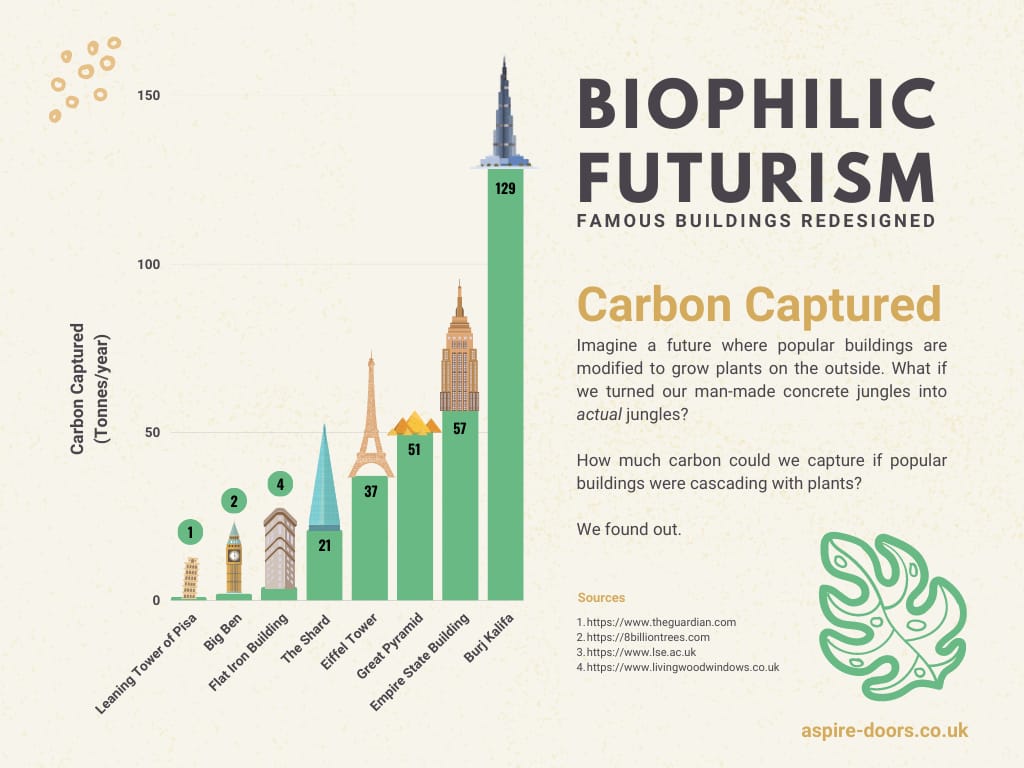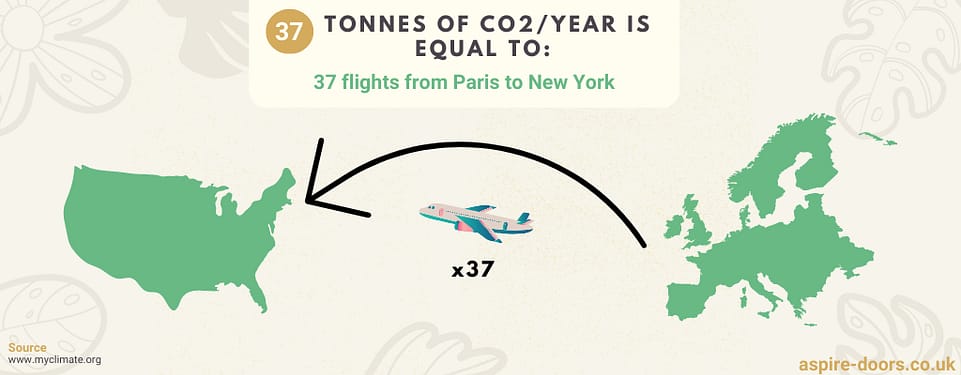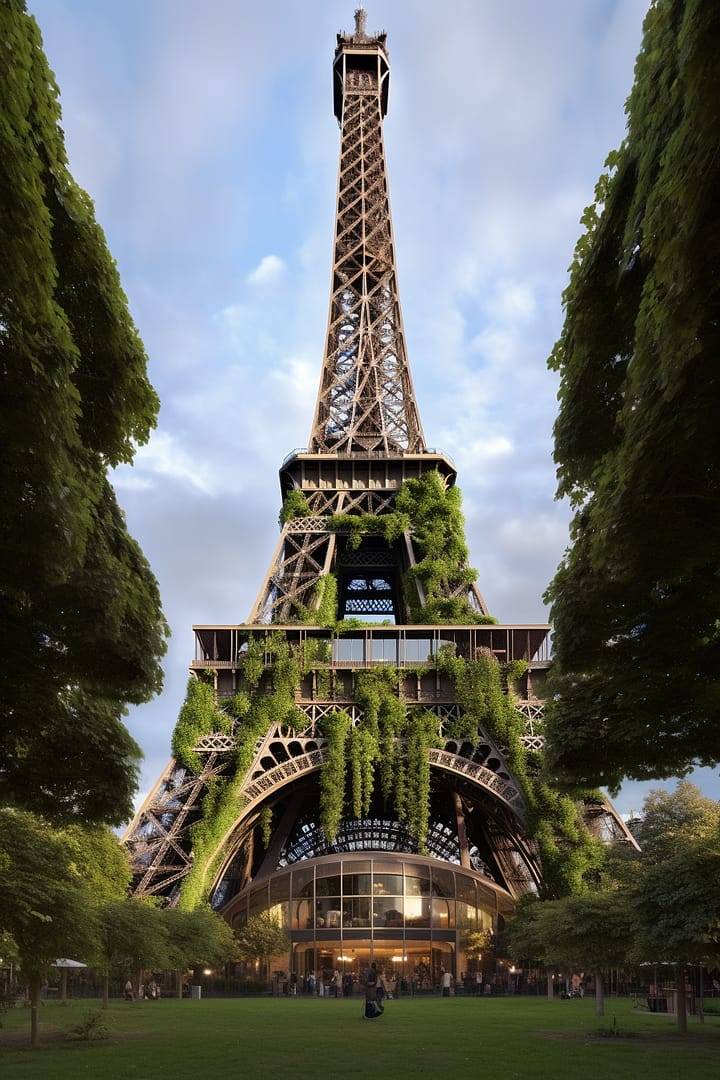
A recent Guardian article states a scary fact: over the last decade, the rainforest emitted 20% more CO2 than it captured
(1). This is due to extreme deforestation in places like Brazil, Indonesia, and the Democratic Republic of Congo (2).
When trees are cut down, there’s a two-part effect on the CO2 emissions:
According to the UN Food and Agriculture Organisation, around 420 million hectares of forest were lost between t
he years 1990 and 2020. The good news is that a) this rate has significantly slowed, and b) Mother Nature is fighting back. Taking into account the
natural expansion of forests, only 178 million hectares have been lost.
These numbers should give us hope, but we need to do much more if we’re going to slow down climate change.

For example: what would happen if we engineered buildings to support the growth of plants?
This is the idea we’ve explored in this article.
We’ve taken 8 popular buildings around the world and used science and maths to calculate how much carbon we could capture every year if we covered 75% of the surface of these buildings in photosynthesising plants.
This percentage leaves enough space for the average amount of building surface area used for windows (4), and a bit extra.
Not only that, but we’ve also asked AI to show us what it thinks these greener buildings might look like! We’ve allowed Midjourney AI to have a bit of creative freedom when it comes to these prototypes – so they may not exactly resemble the original – and it’s worth noting that Midjourney occasionally added fewer plants than we would have liked on the imagery. But, you know, it’s trying its best – the heart is still there.
How could we turn our urban spaces into a biophilic dreamland?
To learn how we calculated the carbon capture, and find out what you can do to help, scroll to the bottom of this page.
Now without further ado – let’s take a look at some of the world’s most popular buildings – but biophilic.
Imagine the Eiffel Tower’s greenhouse cafe. Where you can go to study, work or read while surrounded by cascading plants. This is the sort of romance that we’re looking for when we visit Paris.
One trip from Frankfurt to New York uses around 1 tonne worth of Co2 (1). If we assume three of these flights happen per day, then 1,095 of these flights take place in a year. This building would offset 37 of those trips.
It’s not much, but it’s honest work.


The AI decided to place a beautiful walking garden under the tower – and looks like it straightened the building out while it was at it. While not historically sensitive, this version of The Leaning Tower of Pisa is a great example of what buildings could look like if we engineer them to support plant growth.
The Co2 that this building would capture in one year would be enough to fill 500 fire extinguishers (1).

The AI had a field day with this one. It decided that The Empire State Building needed a series of extensions in the form of luxury apartments. While not visually accurate, it’s definitely a place you’d like to book for your next New York holiday.
This building would capture roughly 59 tonnes of Co2 if it was 75% covered in plants. This kind of biophilic futuristic renovation would cancel out the annual emissions emitted by 13 diesel-fueled cars.

Another beautiful renovation. The Shard is a particularly special building as it not only houses office space but also a five-star luxury hotel, three stories of restaurants and residential space. It’s 72 stories high in the heart of London – the perfect candidate for a vertical urban forest.
Covered in photosynthesising plants, this building would be able to capture 21 tonnes of Co2 every year and turn it back into oxygen. This is the equivalent of the Co2 released from using 48.6 barrels of oil (7).

The tallest building in the world is – of course – in our sights for our new world order. All that vertical plant real estate is perfect for an all-you-can-eat Co2 buffet. Built in 2010, the Burj Khalifa is just over half a mile high (about 830 meters), making it a perfect carbon-capturing machine.
Not only will plants on this building look incredible, but, if done right, they will capture around 129 tonnes of Co2 every single year. That’s enough to cancel out the Co2 emitted from the electricity use of 21 homes in one year! (7)

Once again, AI has had a field day here. While we’re not about to turn the ancient Pyramids into luxury apartments, we can see this type of building existing somewhere else near a desert oasis.
If a theoretical building that matched the size and shape of the pyramids had at least 75% plant coverage, it would capture 51 tonnes of Co2 every year. That’s enough to compensate for the Co2 emitted from burning over 57,000lbs of coal (7) – that’s 9,500 elephants worth of coal! (8)

The Flatiron Building, while not accurately represented here, is one of the most popular buildings in New York City. It sits at 22 stories, or just about 87 metres high at the corner of a sharp turn intersection. It would add some much-needed green beauty to the concrete streets of NYC.
This building would capture around 4 tonnes of Co2, which is equivalent to volume of about 4 hot air balloons (5).

Now for a building we all know and love. Big Ben (or the Elizabeth Tower, as the building is officially known – Big Ben is actually the nickname of the bell that chimes) is an iconic figure for not only London but the entirety of England. While she may not be as tall as the Burj Khalifa, she certainly can play her part in the recapture of Co2. If we were to add a vertical garden to the sides of this popular clock tower, we’d capture around 2 extra tonnes of Co2 every year – equivalent to the Co2 released from almost 2.5 million smartphone charges.
One smartphone can be charged between 300 and 500 times in its lifetime, so this means Big Ben would offset the Co2 emissions from the lifetime of at least 500 smartphones!

So that’s 292 tonnes of Co2 we could be capturing from the atmosphere every year just from 8 buildings! Imagine what we could do if every building was biophilic.
To understand precisely how much carbon these buildings would capture, we had to do a bit of digging…
We found the square footage and height of these buildings and started there. With that info we were able to roughly calculate the surface area of the buildings. We then did some research to determine how much carbon is captured per square metre of photosynthesing plants (spoiler: It’s .5kg/ year), and did a little maths to transfer that data to the square metre surface area of our popular buildings.
Obviously, we can’t completely cover these buildings with plants (we still want to see out of the windows, of course). We found that the average building has around 20% of its surface area dedicated to windows. Then we added an extra 5% to that number to give us some extra space for doors, gutters, and other necessities and decided that 75% of a plant-covered building should do the job.
The only things we need to consider now is:
There’s actually one more thing to consider – and that’s what you can do to help right now.
There are loads of schemes, both in the UK and internationally that are geared towards reforestation and creating a greener future.
Greenpeace.org has a variety of ways that you can take action against deforestation and climate change – from joining your local Greenpeace group and raising awareness to donating monthly to their cause.
With Offset Alliance you can donate directly to plant a tree.
If you’re looking for smaller ways to make an impact, Conserve Energy Future has a list of actions you can take in your daily life to help combat climate change.
At Aspire Doors, we aim to do what we can to help the climate. We supply our products using responsibly sourced material, and all of our external products at least meet (and mostly exceed) the thermal insulation requirements set by the British Building Regulations, helping to keep energy usage down.
Look at some of our most popular external doors to get an idea of what you can do with your next renovation project and keep your home warm this winter – without excessive energy usage!